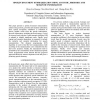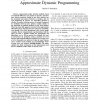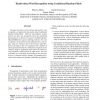125 search results - page 6 / 25 » Document reconstruction using dynamic programming |
ICMCS
2005
IEEE
14 years 3 months ago
2005
IEEE
This paper presents a spoken document summarization scheme using acoustic, prosodic and semantic information. First, speech recognition confidence is estimated to choose reliable ...
PLDI
2010
ACM
14 years 7 months ago
2010
ACM
Calling context--the set of active methods on the stack--is critical for understanding the dynamic behavior of large programs. Dynamic program analysis tools, however, are almost ...
CDC
2010
IEEE
13 years 4 months ago
2010
IEEE
Approximate policy iteration methods based on temporal differences are popular in practice, and have been tested extensively, dating to the early nineties, but the associated conve...
ICDAR
2007
IEEE
14 years 4 months ago
2007
IEEE
The paper describes a lexicon driven approach for word recognition on handwritten documents using Conditional Random Fields(CRFs). CRFs are discriminative models and do not make a...
PASTE
2004
ACM
14 years 3 months ago
2004
ACM
Model checking requires a specification of the target system’s desirable properties, some of which are temporal. Formulating a property of the system based on either its abstrac...



